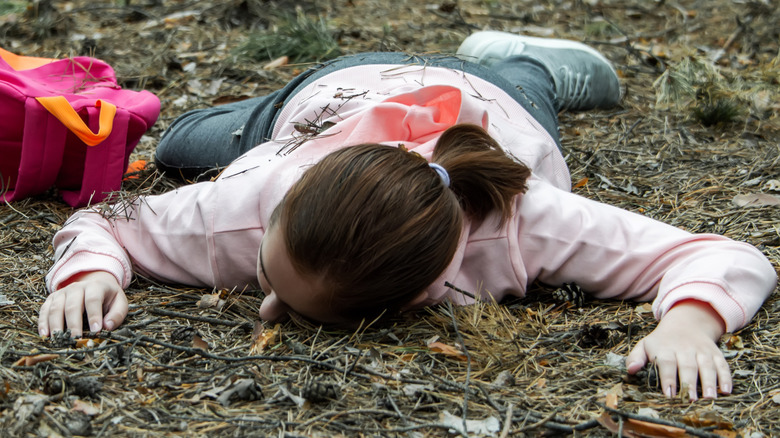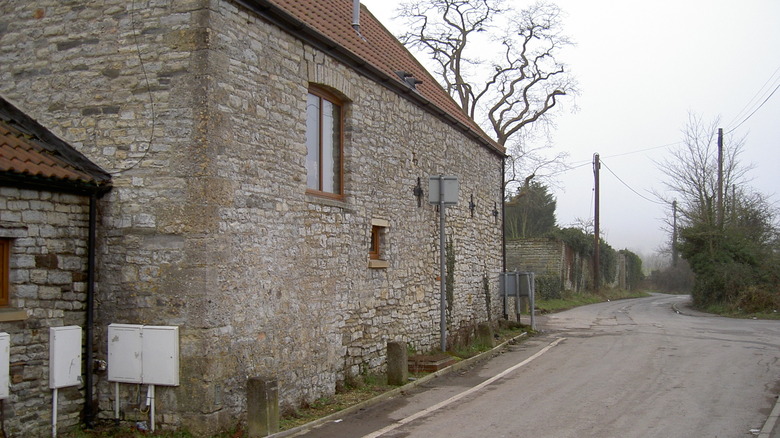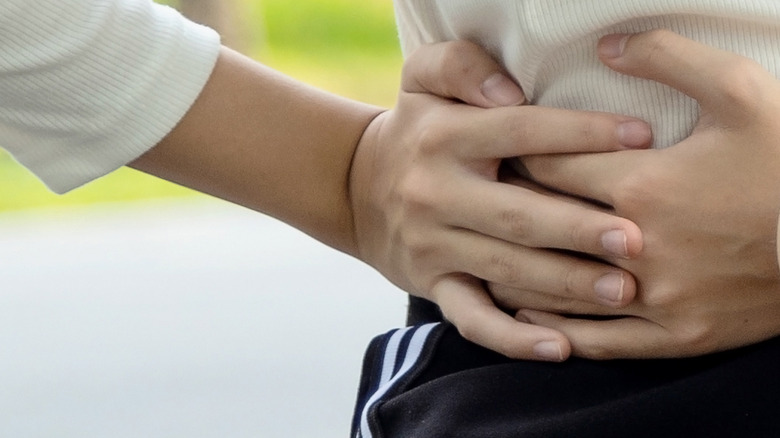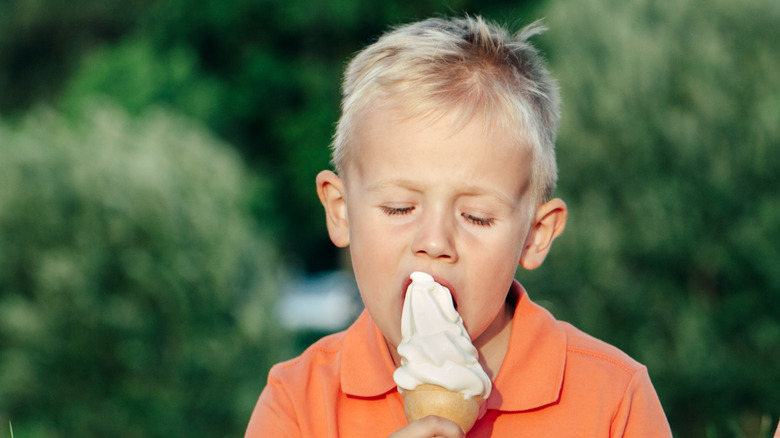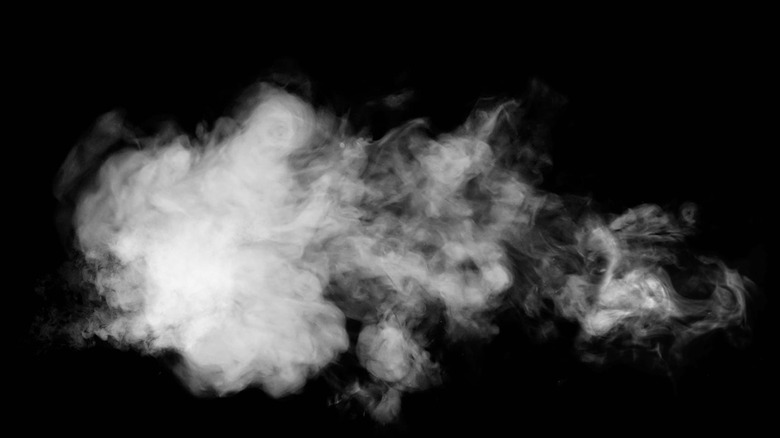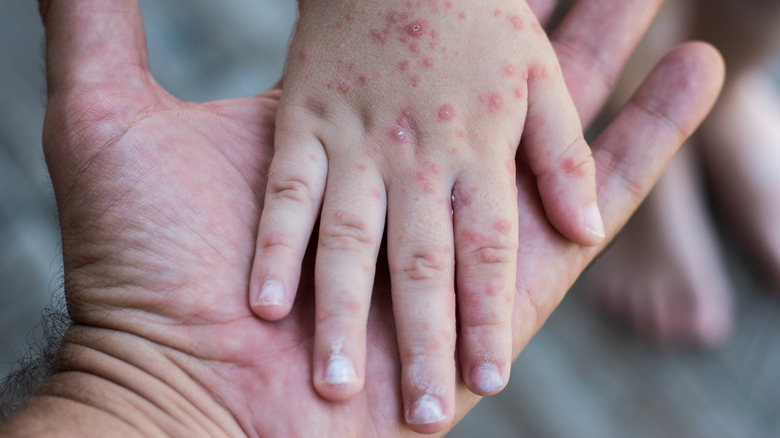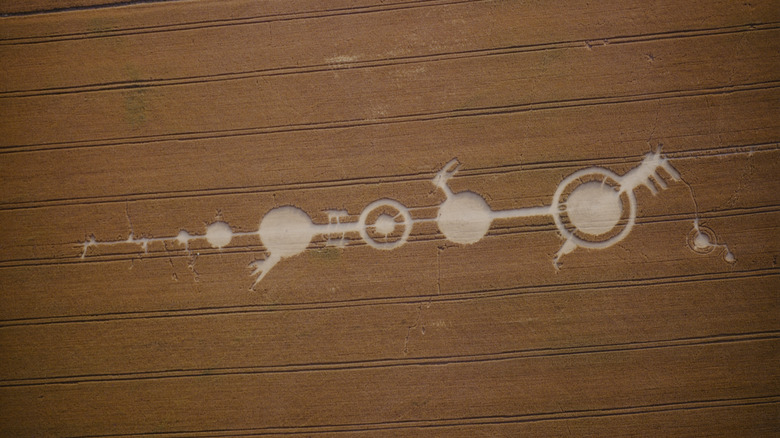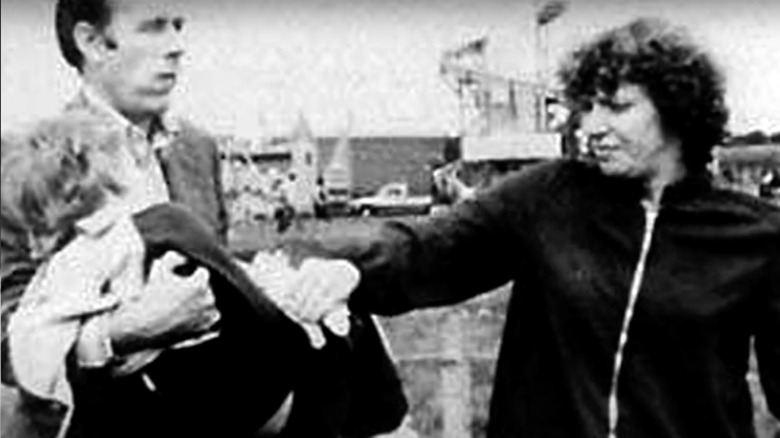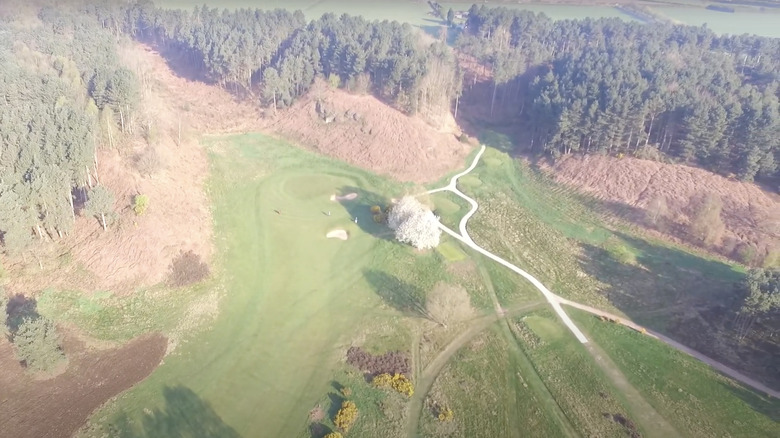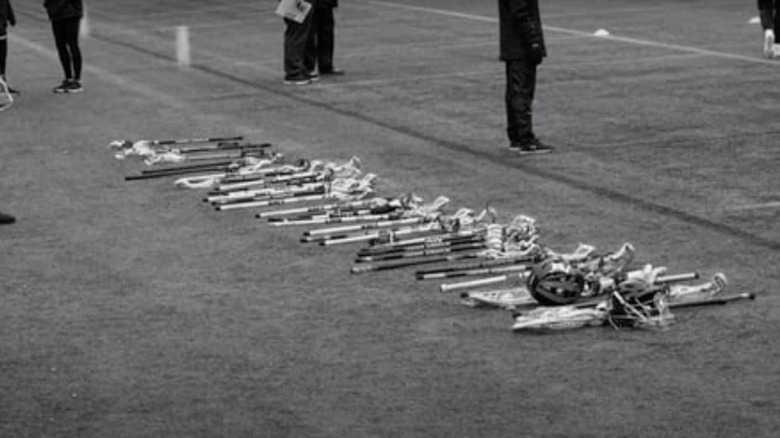Why The Hollinwell Incident Remains Unexplained
Just outside Kirkby-in-Ashfield, a mining town in Nottinghamshire, England, the annual Hollinwell Show took place on July 13, 1980. It featured hundreds of young musicians who competed in various school bands as their friends and family looked on in excitement and pride. That Sunday morning, the musicians were getting ready for the competition. Most of these kids had been up early in the morning to travel to the marching grounds and had been practicing extensively in preparation for this event. After their band leaders nitpicked their uniforms and instruments and practice time was coming to an end before the 9 a.m. start time, the kids were assuredly worn out and overly excited for the competition to start.
Just after 10:30 a.m., the contestants started to collapse. Ultimately, 259 kids were sent to four nearby hospitals. Most were released after examination, but nine were kept overnight, according to Fortean Times. The same report states that 15 adults also suffered from various symptoms similar to the young musicians. One of the young girls said, "We were on the field in full uniform for an inspection... I've never had to stand to attention that long before. ... My friends were collapsing all around me." This strange occurrence would send witnesses, authorities, and the media into a panic as they attempted to find the cause, and many theories would be offered in response to this mysterious event, which would come to be known as the Hollinwell Incident.
Tour of similar incidents, part I
Fortean Times gives a list of prior historical precedents for the mysterious event in Hollinwell. Many of the mentioned cases are hard to track down without the local papers being digitized and available for perusal. However, not all of them have faded into the blind spots of digital knowledge. Take, for instance, the case of Whitchurch, Bristol, where around 500 people watching a race at an abandoned airport reported a "stinging" feeling in their eyes. Many required medical attention for burns on their hands and faces, as well as watery eyes, and around 200 had to come back the next day because the issues hadn't abated.
According to a transcript from the House of Commons in the U.K. Parliament, Mr. Roy Jenkins states what becomes the official explanation: "The trouble was due to dust which was contaminated by tar and free tarry acids from the track, and sensitised the skin and eyes of those affected to sunlight." While this explanation may seem like a reasonable one for a handful of people, it's not hard to see how it might stretch the boundaries of possibility for the people who were affected by whatever took place. This dispute between the victims and the public record becomes a common thread throughout these cases, including the Hollinwell Incident.
Tour of similar incidents, part II
In 1972, Hazelrigg, Northumberland, saw the most similar case to Hollinwell, in that a number people including kids and adults were affected a mysterious mass illness at a festival featuring youth marching bands. According to Fortean Times, band members began to collapse, experiencing severe abdominal pain. In the end, 168 children and a handful of adults were treated, yet doctors noticed that the symptoms went away with time away from the parade fields.
One of the physicians who treated those afflicted stated, "They were all ... frightened and bewildered, many of them believing they had been poisoned and several spontaneously said they had thought that they were dying (via "Mass Hysteria in Schools: A Worldwide History Since 1566"). The same text speaks as well about the familiar dispute that would take place between those afflicted and the medical experts. These cases would become a Rorschach test for how one views such events: Can it all be explained by material rationality, or is there more to this world than what can be divined by science?
First theory - food and drink poisoning
The very first theory to take shape was that the children at Hollinwell had been the victim of some form of food or drink poisoning, to the point that warnings about eating the ice cream or drinking the water were broadcast over the parade ground speakers. Fortean Times reports, "No one is certain whether this announcement happened before, during or after the collapses began." However, it is clear that in the minds of most present, this was the most immediate and comprehensible explanation for what was going on.
This is given a fuller explanation by a photographer, Neil Lancashire, who was there that day and spoke to Nottinghamshire Live about his experience at the ill-fated event, "I did not think much of it to start and then the person over the tannoy said something like 'don't eat the ice cream' as they thought it was causing the fainting. A lot of the children eating ice-cream then fainted." He would go on to say explain that they then thought the water had been contaminated by something sprayed by farmers. It seemed, according to Lancashire, that in the aftermath of these announcements, more children began to pass out and double over in pain. Per the Fortean Times report, however, health inspectors came and tested the food and water and found nothing that would be concerning.
Second theory - gas cloud
The next theory that was posited was the potential for a gas cloud created by pesticides which had been sprayed on the grounds themselves or nearby and carried over by the wind. The investigation did find that a pesticide called Calixin had been sprayed on fields in the immediate area (via BBC News). Calixin contains tridemorph, which the World Health Organization considers "moderately hazardous," and is now banned by the U.K., according to Mysterious Universe. The outlet goes on to give the opinion of a pesticide toxicity specialist: "It's highly unlikely that tridemorph would have caused the children to collapse if they'd been exposed to it directly, given that it isn't harmful to non-pregnant adults or children and it was sprayed in a field several hundred yards away two or three days before."
It also doesn't help that the weather did not lend itself to conditions for tridemorph to have been carried from those nearby fields to the parade grounds on that Sunday morning. The Nottinghamshire Fire Service stated that this was not likely: "The wind was in completely the wrong direction." This, however, did not keep the local papers from publishing panicked headlines about gas clouds knocking out schoolchildren (via Fortean Times).
Third theory - high-frequency radio waves
Once the poisoning and gas cloud options turned up empty, ideas began to get weirder. As reported by Fortean Times, a man from Scotland called the local police and claimed high-frequency radio waves were the culprit. This possible explanation has been mentioned in various other reports on the Hollinwell Incident, including one by Birmingham Live. If that wasn't weird enough, Fortean Times also notes that a high-frequency transmitter was reportedly discovered at a Gas Board depot not far from where the incident took place. The lead wasn't followed, for reasons unknown.
According to the American Cancer Society, if the human body is hit with a large enough amount of radio waves, it can cause tissue damage. The difficulty in this explaining the Hollinwell Incident is that all of the affected people would have to have been exposed to for quite a while and, even then, there is no proof that the effects would manifest so significantly and so immediately as to cause the sort of panic that took place on that Sunday morning.
Fourth theory - mystery bug
Another theory which would pop up in the intense rush to find an explanation was a "mystery bug" which would cause such things as what the locals called "blebs," or water-filled blisters. According to Fortean Times, a doctor speculated that "the Coxsackie virus," presumably referring to the pathogen that causes hand, foot, and mouth disease, was responsible. Per Bupa UK Insurance, hand, foot, and mouth disease often afflicts children, and blisters on the hands and feet are indeed a symptom. Patients typically get better within one or two weeks.
This explanation, at least, fits the timeline of the initial event to the time of recovery, but it does not seem to explain the immediate symptoms on that day. It would be reported that hand, foot, and mouth disease was ultimately left behind as a possible solution to the mystery due to its inability to explain the diversity of effects on people during the event (via Fortean Times). Once again, the investigation finds itself at a dead end. From this point on, the theories only become stranger and more fantastical.
Other odd theories
Weird events like this always bring the possibilities of aliens and UFOs into the fray. According to Fortean Times, about a week after the Hollinwell Incident, the Daily Telegraph ran a story about claims of a UFO landing in a nearby field, which the police investigated. It doesn't seem as if too many victims or investigators gave the idea of UFOs any more attention than this one case, though. Most of the investigations were focused on food and drink poisoning or pesticides and possible illnesses.
Another odd theory about what took place that day in 1980 is expounded by a website called End Times Prophecy Report in direct opposition to what would become the leading theory about what took place in Hollinwell: mass hysteria. The website states, "Freud and his cohorts manufactured the lie of mass hysteria to hide what could no longer be hidden or explained with the lies which were then being used." They go on to say that what really took place was a display of demonic power. So, according to them, Satan and/or his minions were wreaking havoc on that parade ground in 1980, and this is the case in any event that is described by experts as a case of mass hysteria.
The most accepted theory - mass hysteria
Once most of the theories were found to be incapable of fully explaining the Hollinwell Incident, most experts began to suspect that this was a case of mass hysteria, or epidemic hysteria. At the time, this idea was put forth by two doctors, Dr. William Thomson and British Psychological Society spokesman Dr. John Nicholson, who both offered mass hysteria as an explanation for what took place in two separate newspaper articles (via Fortean Times). In a piece for The Observer, Denise Winn wrote, "It was primed by a combination of the anxiety of performing and the tension of waiting for a long period at attention, so that when the trigger came — 'Two children collapsed first, then two more...' — the rest followed in a mounting wave of unintentional mimicry" (via "Mass Hysteria in Schools: A Worldwide History Since 1566").
One of the kids present during that day, according to Birmingham Live, holds to the mass hysteria theory now as an adult saying, "As for the cause, who knows? Thinking about it now, I'd say it was hysteria — a large gathering of children, excited and also nervous about a competition which they took very seriously. You have to remember that there was a lot of healthy rivalry in those marching bands." This is the tack that most have taken in explaining the events.
Sociogenic hysteria
Another form of mass hysteria that came up in connection with the Hollinwell Incident is sociogenic hysteria. According to the Canadian Medical Association Journal, this involves the "rapid spread of illness signs and symptoms affecting members of a cohesive group, originating from a nervous system disturbance involving excitation, loss or alteration of function." Basically, think about the nature of psychosomatic illness spreading among a group of people within a certain context where nerves are heightened. The excitement and weariness felt by a bunch of kids who had been up and practicing for a while and were nervous about the upcoming competition might have been enough for sociogenic mass illness to take place.
Dr. Robert Bartholomew notes that this has happened throughout history. The forms it took on varied from "convent fever" to "panics" at factories, theaters, and schools. Dr. Bartholomew "has taken to calling the illness 'protean' in that it can take on or mimic the symptoms of other illnesses appropriate to the cultural milieu" (via "The Rough Guide to Unexplained Phenomena"). If the idea of mass hysteria is medically plausible, then it seems sociogenic illness might be the most likely culprit for the Hollinwell Incident because it would explain the immediacy of the event as well as the eventual dying down of symptoms once people had been removed from the context.
Hysteric aftermath
Another truly strange element of this tale is what happened after the initial event. According to Fortean Times, three days after the Hollinwell Incident, four people in Worksop, not far away, suddenly suffered similar symptoms. The publication goes on to cover related incidents, including one that took place the next weekend: One of the bands originally affected at Hollinwell again passed out during a band march. Also, two weeks after the Hollinwell Incident, 19 children fell ill on a bus ride from Lincoln to Leicester. It seemed that whatever was going on was not strictly tied to that immediate local context but was spreading out almost like a pandemic.
Fortean Times notes, "For the anti-hysteria lobby, there was a serious question about the way the 'illness' was transmitted from the children in the arena to others outside it." There was enough oddity abounding that it made it difficult for those who were present and got sick — or saw loved ones get sick — to accept the diagnosis of mass hysteria, and the outside cases made questioning the prevailing expert opinion easier.
The media frenzy
According to Dr. Robert Bartholemew and Bob Rickard, "Sloppy and excitable reporting dogged the event and undoubtedly contributed to the overall confusion in the wider public. For example, the Guardian reported that traces of blood and protein had been found in samples of urine taken from some of the children, possibly indicating kidney damage" (via "Mass Hysteria in Schools: A Worldwide History Since 1566"). It seemed misinformation around what actually was involved in the diagnosis of mass hysteria was prevalent in reporting — and still was during later re-investigations into the Hollinwell Incident, such as one the BBC did in 2003.
According to Fortean Times, in response to the BBC's documentary on the Hollinwell Incident that year, viewers made such statements as, "Mass hysteria is a way of covering up the truth." With these misconceptions around what mass hysteria or sociogenic illness entails, it is not hard to see how the parents of the afflicted children would be furious, as "they resented, as they saw it, being labelled 'weak-minded' or worse (via Fortean Times).
'Joke jelly babies'
Fortean Times reported that there was an aspect of the Hollinwell Incident that was easily missed in all of the reporting done on it. Before the event took place, there had been an announcement over the intercom warning people to not consume "joke jelly babies," similar to gummy bears in America. The outlet speculates that this might have been what got the ball rolling. It's worth noting that investigators couldn't determine if the later reported warnings about eating the ice cream actually happened at all.
The panic was only heightened by two mothers and their infants: One looked down to see her baby covered in blisters, and the other could not rouse her baby from sleep — this woman's panic was only made worse by what was beginning to happen around her, according to "Mass Hysteria in Schools: A Worldwide History Since 1566." All of this, paired with the possible announcements and the children falling over one by one, would explain the context in which some form of hysteria could have easily been stoked.
Why has the Hollinwell Incident still not been explained?
With events like the Hollinwell Incident, it is hard enough to get to a conclusion within a typical investigation, but when one adds in the media frenzy, the conflicts between the public record and witnesses, and the continuous misinformation and misconceptions that abound, it is not at all surprising that the truth became subsumed within the wider hysteria of high-profile cases like these.
Among the many missing pieces of information is the lack of knowledge of who, in fact, was the first child or adult to fall ill or faint, not to mention whether or not there were additions announcements made over the intercom after the warning about "joke jelly babies" that stoked the theories of food and drink poisoning. There was also a radio bulletin stating that a horse fell ill during the Hollinwell Incident, as did five other horses during a subsequent event. The animals reportedly had to be put down. Neither of these claims were confirmed as true by the organizers of the events and the investigators, according to Fortean Times.
It also doesn't help that no matter how conclusive an investigation is, there will still be those who refuse to believe the official explanation, whether due to misconceptions or outlying evidence that doesn't quite fit the official record. Instead, we are left with a big question mark. As a parent of one of the affected children put it, "There has been a cover-up. Some people are still feeling ill, so how can it have been hysteria?" (via Fortean Times).
